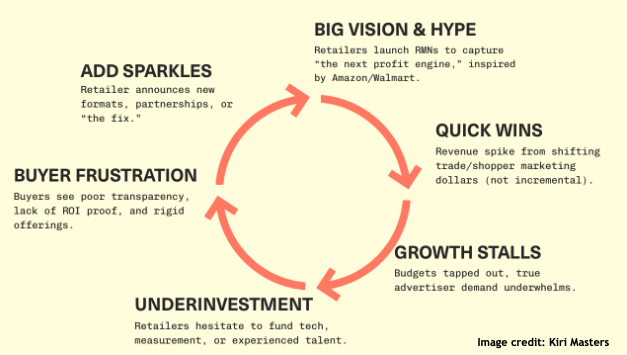How to break the doom loop of retail media
More and more large retailers are turning to selling ads – for very good reason. Their digital storefronts are full of premium ad space for brands and agencies. So looking for a quick win, retailers hastily hatch a plan to start selling all the ad inventory they have on their site, along with sponsored search ads.
A retail media network – of sorts – is born.
But all too commonly, the plan quickly starts to stall. Smart retailers don’t want to place a blockade of ads in the way of a purchase, as this would destroy the user experience. So there is less ad space to sell than retailers first imagine. Revenue consequently hits a ceiling and the growth of a retail media network stalls as quickly as it seemed to take off.
Retail media analyst Kiri Masters put it well when she described the situation as a “doom loop”. Growth taps out. Your RMN investment declines. Ad buyers fall away due to poor transparency, lack of ROI proof, and rigid offerings. And before you know it, you’re having to resuscitate the network with another burst of big-vision hype, which fails to work.
A better path lies in offsite retail media, which grants retailers unlimited inventory using first-party data to sell buyers the ability to place ads on any site targeted to their audience. But this in and of itself doesn’t break the loop. To crack how you’re going to monetize your audiences, you need the tools to help you look within and beyond your onsite inventory.
Investing in RMN technology is the answer.
Consolidated retail media solutions for omnichannel ad monetization
Running a retail media network and ad sales business gets very complicated very quickly. First there’s all the onsite media, search, sponsored ads, social, and offsite ad products to manage at any one time. Then there’s the ton of different point solutions and tools that retail media sellers have to use to do that, from Google and Trade Desk accounts, to search and social partners like Criteo and Kevel.
While you can’t replace these tools, a solution like AdSalesOS from Placements.io can consolidate the workflow and data into one place. You get a single source of truth for billing, proposals, ad ops, and reporting.
Yet Kiri wrote that “many retailers know their tech stacks are suboptimal”. She could have gone one further: many retailers don’t have anything you could really call a tech stack when it comes to running advertising all the way from quote to cash. They rely instead on spreadsheets to handle the entire lifecycle. Without a meaningful tech foundation, it’s almost impossible to take a retail media business into the next level of sophistication, scale, and growth.
With an aggregated retail media solution, you can identify and orchestrate all your onsite and offsite opportunities to monetize your inventory and grow your brand partnerships. By bringing all your data and insights together, you can more easily create a flexible offering to meet different ad buyers’ needs. Rather than a risky investment, a consolidated retail media solution ensures revenue opportunities and profit aren’t left on the table.
But there’s another hurdle for retailers in communicating the benefits of a retail media solution to their advertisers.
The need for transparency around retail media solutions
Kiri identified a “shame factor” among RMNs over the sometimes simplistic technology they rely on to sell advertising. They can easily become reluctant to make advertisers aware about what they’re using to manage their campaigns. It’s a major missed opportunity.
Retailers can win clients’ trust, deepen their advertising partnerships, and grow their retail media network if they can show that the technology they’re using improves advertiser outcomes. With the right retail media solution in place, they can be transparent and vocal about how their tech provides faster proposals, more accurately optimizes campaigns in real time, and unlocks new channels and ad products. If budget's placed against an ad initiative that's not performing, a good retail media solution should offer the ability to efficiently shift that budget to meet advertisers’ goals.
The result? Retailers can demonstrate how they serve advertisers more completely in terms of the customer journey they’re trying to impact, from social all the way through to in-store.
Yet even retailers with a good ad-selling tech stack in place treat these capabilities like secrets instead of competitive advantages they should be promoting. Retailers’ pitch to advertisers often stops too short, discussing the potential value of their audience, but not how the retailer will make it most effective for them. So even if retailers escape the doom loop by taking advantage of consolidated retail media solutions, they risk falling into another vicious cycle by masking their technological capabilities and falling behind competitors.
That’s why an integrated ad sales platform like AdSalesOS is so important. Not only does it give retailers the confidence and clarity to optimize campaigns. It enables retailers to demonstrate concrete ROI and more effectively differentiate on their tech. Finally putting an end to the doom loop of retail media.
Drop us a line to find out more about how AdSalesOS can drive a more profitable ad-selling operation.


.png)

.png)

